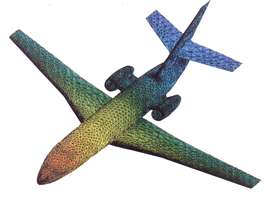
|
|
||||||||
Flights of fancy spread their wings
It is a remarkable fact that turbomachines anywhere in the world are likely to have been designed using software developed in Cambridge by Professor Bill Dawes and Professor John Denton. The 'Dawes Code' and 'Denton Code' are now industry standards. Professor Dawes started using computational fluid dynamic (CFD) techniques to model fluid flows for aerospace applications back in 1976, shortly after the first calculations in this field were made possible by the development of computing power.
'In a sense,' he comments, 'we have solved most of the problems in CFD (apart from turbulence modelling). Using the technique of computational fluid dynamics, our understanding of aerospace systems and situations is improved and with improved understanding comes improved design. The only limit with these techniques is your imagination. An exciting trend now is to apply our models, developed using the rigorous and demanding approach required by the aerospace industry, to other areas.' With this in mind, a team of academics is combining to apply CFD to diverse problems ranging from explosions on oil rigs to particulate damage in lungs.
 Finite
volume mesh for a plane prepared for a CFD simulation. Half the cost
of an airline ticket is taken up with the cost of ownership; using
CFD techniques, testing and design times can be reduced, and designs
can become more adventurous. Finite
volume mesh for a plane prepared for a CFD simulation. Half the cost
of an airline ticket is taken up with the cost of ownership; using
CFD techniques, testing and design times can be reduced, and designs
can become more adventurous. |
